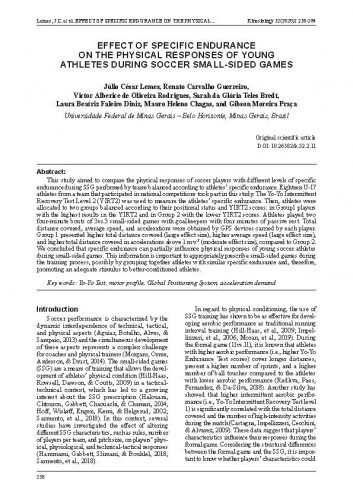This study aimed to compare the physical responses of soccer players with different levels of specific endurance during SSG performed by teams balanced according to athletes’ specific endurance. Eighteen U-17 athletes from a team that participated in national competitions took part in this study. The Yo-Yo Intermittent Recovery Test Level 2 (YIRT2) was used to measure the athletes’ specific endurance. Then, athletes were allocated to two groups balanced according to their positional status and YIRT2 scores: in Group1 players with the highest results in the YIRT2 and in Group 2 with the lower YIRT2 scores. Athletes played two four-minute bouts of 3vs.3 small-sided games with goalkeepers with four minutes of passive rest. Total distance covered, average speed, and accelerations were obtained by GPS devices carried by each player. Group 1 presented higher total distance covered (large effect size), higher average speed (large effect size), and higher total distance covered in accelerations above 1 m·s-2 (moderate effect size), compared to Group 2. We concluded that specific endurance can partially influence physical responses of young soccer athletes during small-sided games. This information is important to appropriately prescribe small-sided games during the training process, possibly by grouping together athletes with similar specific endurance and, therefore, promoting an adequate stimulus to better-conditioned athletes.
Sažetak

 Kinesiology : 51,2(2020) / editor-in-chief Dragan Milanović.
Kinesiology : 51,2(2020) / editor-in-chief Dragan Milanović.